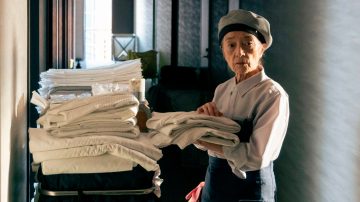
With prices soaring seemingly every day, it’s never been more difficult to make it in the creative industries. Lara Olszowska speaks to three young filmmakers in London about how they’re navigating this unprecedented cost-of-living crisis.
The film industry is an unstable and unpredictable beast at the best of times. Anyone reading the daily news headlines would be right to assume that we find ourselves, at least economically, in the worst of them.
For aspiring directors, getting work, getting paid for that work, and ensuring a steady stream of subsequent work – be it for narrative shorts, feature films, TV series, ad campaigns or music videos – there are many obstacles to overcome. According to three London-based filmmakers early in their careers, the biggest of these is financial. So, how did they break into the industry, and is the cost-of-living crisis threatening their ability to stay working in it?
Michael Junior Onafowokan is 26, Peckham bred, BRIT school trained, and has been working both in front of and behind the camera since 18. After graduating from university with a degree in editing and post-production, he worked as an actor in adverts and TV shows, including Netflix’s hit series Top Boy.

Top Boy has been a huge hit for Netflix. Credit: Netflix
He treated time on sets as a learning opportunity to help him pursue his true passion – writing and directing. “I didn’t know the business and marketing side or how important film festivals were,” he says. “I used to speak to the producers and ask them questions and they’d give me a breakdown and everything.” Even more valuable on set, was the chance to make industry contacts. “If it wasn’t for being on set as an actor, I wouldn’t have met probably 80% of the people who worked on my shorts,” Michael reflects.
Leading up to and during lockdown, Michael built an impressive body of work, including Being Black (2021), for which the BFI Future Film Festival nominated him Best Director.
Of course, this did not come easy or cheap. Michael sacrificed going out and focused on saving up to ensure his films were made – the most expensive one had an £8000 budget. “I was doing edits for people, working at youth clubs, odd jobs, filling out market research surveys, anything to make cash. It was a bit of a blur,” he says. “I was also doing stuff for free for people. Giving my time to their projects so they would help me on mine.”
The hard graft has paid off all but monetarily for Michael: “I’m able to be in different rooms now in terms of writing and directing. I can’t say it’s brought money, but it’s brought opportunities.” Opportunities won’t pay London’s ridiculous rent, so Michael is living on the outskirts of London with his family, working on projects and hoping to move out soon. “I could be one phone call away from just everything turning. So, I’m trying to make sure I’m available and doing the groundwork until that happens,” he says, “but the cost of living has made me wonder if maybe I do need to get another job.”

Michael Junior Onafowokan. Photo by Sama Kai Sundifu
It’s a toss-up that film director and screenwriter Harry Richards, 24, knows only too well. Since graduating mid-pandemic, Harry juggled a post-production job with filmmaking, and now a PR job with promoting his latest short film, SANTI. He’s hoping it will turn into a feature, but this will likely take years given the financial barriers and having to work two jobs. “It’s incredibly hard when you are starting out as a filmmaker, and you don’t have a huge amount of money to spend, so you are constantly looking for favours,” he says, “so it takes much longer to get your first film off the ground.”
To raise the £7500 budget for the short, Harry turned to the crowdfunding service Greenlit and SANTI became the fastest funded film on the platform. The next challenge was getting that film in front of audiences, and after ringing round independent cinemas, Harry found that screenings could cost anything from £500 to £3000. “You’re competing with the big studio
films that are able to pay and book out a two-hour slot in these cinemas, which can cost a lot of money,” Harry explains. With cinemas out of his price range but not wanting to resort to showing the film only online, Harry decided to take SANTI on a university tour around the UK. “It’s the best way to see a film. You sit with an audience, and you have this communal engagement with subject matter,” Harry affirms.

Harry Richards. Photo by The SANTI Production Team
Despite the rapidly rising cost of living, Harry’s outlook remains optimistic: “I hope we should still be able to make films even in a challenging financial time.” For him, the rewards are worth spending on, and he is prepared to struggle through it. “If you want the opportunities that London gives you like networking, events, festivals, cinemas, and everything the London film scene has to offer, then you also have to pay the extortionate rent. That’s the reality,” he says. Being BFI-selected for the Future Film Festival is one benefit London has brought him, even if reasonable bills it has not.
Almost five years into her career shooting music videos and campaigns for fashion brands, Silence, 27, is affording life in the capital by living with family in South London. “I want to move out, but I just can’t. I don’t know how I would still do my career if I wasn’t living rent free right now,” she says. Silence spent the first two years out of uni making music videos and promotional videos, mostly unpaid. This was only possible because she secured £400 monthly rent in a North London warehouse and worked a bar job all weekend with the occasional flyering and runner jobs thrown in. A room in that same warehouse now costs £525 a month – I checked.
“I don’t think it’s bad in those [early] stages to work for free. I think you have to weigh up the benefits of the job,” she says. “When I just have to make a 30 second fashion film, it’s a fun day, and they pay for my travel and I know it’s going to be great on my reel, why say no?”
For Silence, accepting unpaid work for a fashion magazine had its upside and led to more work. “It seems to be once you work at one magazine, you climb through all of them,” she says. Her network has been essential for keeping a side job within the industry too. “Any time it does go really quiet, I can hit up some contacts and see if there’s any edit work I can do,” she says.
Silence has just finished shooting a music video for Rag’n’Bone Man and doesn’t know what her next project will be. “There’s a lot of talk of jobs that people then get scared to actually fund and it’s very frustrating. I feel that people are a bit anxious to spend,” she says. Still, her attitude to work seems unaffected and positive. “I’m loving the music videos but there are fashion brands I really want to work with. And I want to do more commercials to get the money up,” she says.
It’s hardly surprising that all my conversations with these three young filmmakers boil down to money, given that it is on everyone’s mind more than ever. The question remains whether they will keep their momentum in the face of ever harsher realities. So far, it seems they’re doing a pretty good job.



